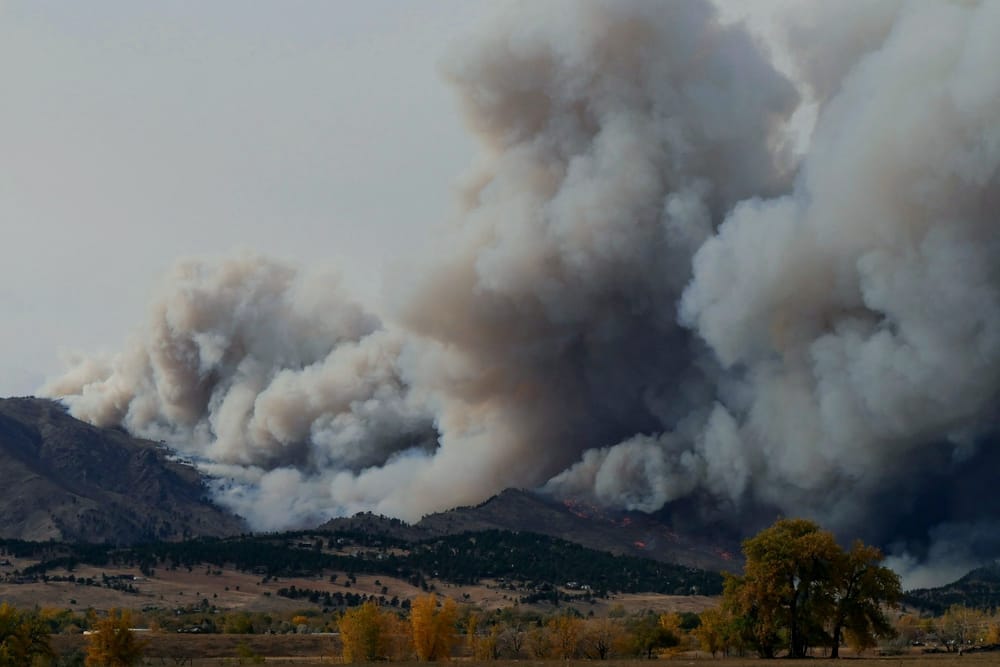The Creeping Politicization of Wildland Firefighting
Recent developments call into question the administration's ability—and willingness—to fight fires on public land.
When you live in the Mountain West, you live with the reality that on any spring or summer morning, you might wake up to a subtle orange haze and the distinct smell of smoke. Step outside and you may also see an ominous cloud so large that you'd be forgiven for first believing you're witnessing a nuclear explosion.
In April 2022, I awoke in my home in Santa Fe to these exact conditions: an eerie haze that diffused the sunrise, air that instinctively felt unsafe to breathe, and, out my back porch, what looked like a massive thunderhead expanding over the Sangre de Cristo Mountains east of town. Only, thunderheads don't typically appear here before midafternoon.
I was witnessing the opening salvo of the Calf Canyon/Hermits Creek Fire, a conflagration that would become the largest wildfire in New Mexico history. It burned for nearly three months and scorched more than 341,000 acres. Living in the shadow of such a blaze is disconcerting and sometimes frightening, but you learn to coexist with it, comforted by the fact that you can typically rely on the federal government pouring every available resource into quelling such an inferno.
Now, it seems, we can no longer take that commitment for granted. America is a few months into what is gearing up to become one of the worst fire seasons on record, yet three recent developments call into question the Trump administration's ability—and willingness—to fight fires on public land and protect the most endangered surrounding communities. Here's what we at RE:PUBLIC are worried about.
ONE: The use of FEMA and other forms of disaster relief as a political cudgel
Last week, a public spat erupted between President Trump and Maryland's Democratic governor, Wes Moore, over the president's threat to send National Guard troops into Baltimore to clean up what he described as a crime-infested "hell hole." When Moore pushed back on Trump's description of the city’s conditions, Trump quickly retaliated. "I gave Wes Moore a lot of money to fix his demolished bridge," he posted on Truth Social, referring to the Francis Scott Key Bridge, which was famously damaged in a shipping accident last year. "I will now have to rethink that decision???"
The threat—if you don't do what I want, I'll withhold federal aid—should come as no surprise. President Trump repeatedly made such proclamations during his first term and throughout his 2024 campaign. California is his most common target. Last September, Trump said that California governor Gavin Newsom would “sign those papers,” seemingly a reference to a 2020 federal move to boost water deliveries to farmers by loosening endangered-species protections—a policy Newsom had challenged in court. He warned that if Newsom refused, the state would not receive federal funding for wildfire response: “And if we don’t give him the money to fight the fires, he’s going to have a problem.”
There are currently more than 15 active wildfires in California, and Newsom and Trump are embroiled in a bitter social media war of words. One can't help but worry: Is the president going to pull firefighting resources from the state over a political dispute?
TWO: The severe reduction of firefighting resources
According to an excellent July 2025 investigative report by ProPublica's Abe Streep, while the Forest Service insists it is fully staffed for an intensifying wildfire season, internal data reveals thousands of vacancies. According to a Forest Service employee who has seen the data, DOGE budget cuts and voluntary resignations have left the agency understaffed—with as many as 27 percent of positions unfilled.
"The employee said that while the data could contain inaccuracies in certain forests," writes Streep, "it broadly reflects the agency’s desired staffing levels. The employee said the data showing 'active' unfilled positions was 'current and up-to-date for last week.'"
In other words, the shortage is ongoing at a time when more than a million acres are burning across 10 western states.
The administration denied the report, but even if personnel numbers are what they say they are, some of their approaches to firefighting remain concerning. In June, Trump ordered the the U.S. government to centralize firefighting efforts, which are now split among five agencies and two cabinet departments. Trump’s proposed 2026 budget calls for the creation of a new Federal Wildland Fire Service under the Department of Interior. The order could mean shifting thousands of personnel from the U.S. Department of Agriculture’s Forest Service, which employs most federal firefighters, with fire season already under way. It's a potential recipe for chaos.
THREE: Trump's view that wildfires are another reason to justify more logging
The president has long admired his interpretation of Europe's approach to firefighting. In 2018, while visiting the ruins of the Camp Fire in Paradise, California, Trump lauded Finland's strategy, claiming the country avoided wildfires by “raking” and cleaning forest floors. Believing that preventing blazes like Camp Fire is simply a matter of better resource management, Trump advocated for more logging and thinning on national forests during his first administration, though he made little effort to direct policy changes.
In his second stint as president, Trump has been much more aggressive, citing wildfires as a justification for massive increases in logging. Last April, he used an executive order to rescind the "roadless rule," which protects millions of acres from logging activities. In addition, interior secretary Doug Burgum and agriculture secretary Brooke Rollins have promoted a forest management overhaul, including a 25 percent increase in timber harvests and a reduction of hazardous fuels—a.k.a. the "raking" Trump referred to—across 6.5 million acres annually.
Fire experts refute the administration's claim that increased logging will help decrease fire danger. A study published in Global Change Biology in May found that lands managed by private timber companies were about 1.5 times more likely to experience “high-severity” wildfires compared with public lands that have lower levels of timber harvesting.
The Good, the Bad, and the Ugly
Every Friday, our team shares critical stories about public lands from around the internet. This list could be exhaustive and exhausting, but our intent is to inform, not overwhelm. Instead, we choose three to five important stories you should be aware of—including at least one piece of good news.
The Good: BLM Visitors Chafe at Burgum Request to Review ‘Negative’ Signs: "Some of the 68 comments BLM received over the summer questioned the agency for asking the public to identify signs or other information that may disparage America and its history. The Sierra Club obtained the comments through a public records request. 'Is the truth offensive to you people?' one anonymous visitor to a California site wrote in a June 27 comment to BLM."
The Bad: A Sneaky Way Lawmakers Can Sell Your Public Land, and 3 Other Things Insiders Won’t Say on the Record: "While most hunters and anglers agree that a sell-off amounted to the worst-case scenario—a firesale that’s almost impossible to reverse—it’s far from the only threat facing the public lands, waters, and wildlife we cherish. But many biologists and conservation advocates are still too scared to talk about them. They worry they could lose their jobs or federal funding, or piss off their members if they speak candidly about the threats that currently scare them the most. So Outdoor Life called a handful of experts and let them talk on condition of anonymity. Here’s what they want you to know about some of the ways hunting, fishing, and outdoor recreation are at risk."
The Ugly: Trump’s Interior Department Is Turning Environmentalists’ Legal Playbook Against Them: "The Department of the Interior, or DOI, has such a wide-ranging set of duties that it’s sometimes referred to in Washington, D.C., as “the department of everything else”—public lands, natural resources, wildlife regulations, and the Bureau of Indian Affairs all fall under its auspices. It is now also the tip of the spear in the Trump administration’s war on renewables."




